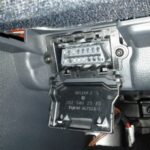If your Chevy 2000 K3500 is experiencing issues with the OBD2 system, you’re not alone. This article outlines common problems and potential solutions to help you troubleshoot and get your truck back on the road.
The On-Board Diagnostics (OBD2) system is crucial for monitoring your vehicle’s emissions and overall performance. A malfunctioning OBD2 system can lead to failed emissions tests, poor fuel economy, and even drivability problems. For a Chevy K3500 truck, especially a 2000 model year, understanding the nuances of the OBD2 system is essential.
Common Causes of OBD2 Issues in a Chevy 2000 K3500
Several factors can contribute to a non-working OBD2 system in a 2000 Chevy K3500:
- Faulty OBD2 Scanner: The scanner itself might be defective or incompatible with your truck. Always ensure you’re using a scanner designed for OBD2 systems and compatible with GM vehicles.
- Loose or Damaged OBD2 Connector: The connector, located under the dashboard, can become loose, damaged, or corroded over time. Inspect the connector for any visible damage, bent pins, or loose connections.
- Blown Fuse: A blown fuse in the OBD2 circuit can prevent the system from powering on. Consult your owner’s manual to locate the specific fuse related to the OBD2 system.
- Wiring Problems: Damaged or corroded wiring in the OBD2 circuit can disrupt communication between the scanner and the vehicle’s computer.
- Faulty PCM (Powertrain Control Module): The PCM is the brain of your truck’s engine management system. A malfunctioning PCM can cause various problems, including OBD2 communication failures. This is a less common issue but requires professional diagnosis.
- Aftermarket Stereo Installation: Incorrectly installed aftermarket stereos can sometimes interfere with the OBD2 system’s wiring.
Alt: Close-up view of an OBD2 connector, highlighting the various pins and their arrangement.
Troubleshooting Steps
- Check the OBD2 Scanner: Test the scanner on another OBD2 compliant vehicle to rule out scanner malfunction.
- Inspect the OBD2 Connector: Visually inspect the connector for damage. Use a flashlight to check for bent pins or debris. Try reconnecting the scanner firmly.
- Check the Fuse: Locate the OBD2 fuse using your owner’s manual and check if it’s blown. Replace it with a fuse of the same amperage if necessary.
Alt: Image showing a vehicle’s fuse box with various fuses and relays, emphasizing the importance of checking fuses for OBD2 problems.
- Check for Diagnostic Trouble Codes (DTCs): Even with a seemingly non-functional OBD2 system, sometimes DTCs might be stored. Try using a different scanner or consult a professional mechanic to retrieve any stored codes. DTCs can provide valuable clues about the underlying issue.
- Inspect Wiring: If you have experience with automotive wiring, you can visually inspect the OBD2 wiring for damage. Look for any signs of corrosion, cuts, or loose connections. However, this step is often best left to a qualified mechanic.
When to Seek Professional Help
If you’ve tried the basic troubleshooting steps and your Chevy 2000 K3500 OBD2 system is still not working, it’s time to consult a professional mechanic. They have the expertise and tools to diagnose complex electrical issues and repair or replace faulty components. A professional can pinpoint the problem using advanced diagnostic equipment and provide the necessary repairs.
Conclusion
A malfunctioning OBD2 system can be frustrating, but by understanding the common causes and following the troubleshooting steps outlined above, you can often identify and resolve the issue. However, for more complex problems, seeking professional help is crucial to avoid further damage and ensure a proper diagnosis and repair. Remember, a functioning OBD2 system is essential for maintaining your truck’s emissions compliance, performance, and fuel efficiency.

